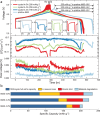Kinetically Dormant Ni-Rich Layered Cathode During High-Voltage Operation
- PMID: 40025928
- PMCID: PMC11983239
- DOI: 10.1002/adma.202419253
Kinetically Dormant Ni-Rich Layered Cathode During High-Voltage Operation
Abstract
The degradation of Ni-rich cathodes during long-term operation at high voltage has garnered significant attention from both academia and industry. Despite many post-mortem qualitative structural analyses, precise quantification of their individual and coupling contributions to the overall capacity degradation remains challenging. Here, by leveraging multiscale synchrotron X-ray probes, electron microscopy, and post-galvanostatic intermittent titration technique, the thermodynamically irreversible and kinetically reversible capacity loss is successfully deconvoluted in a polycrystalline LiNi0.83Mn0.1Co0.07O2 cathode during long-term charge/discharge cycling in full cell configuration. Contradicting the dramatic capacity loss, the layered structure remains highly alive even after 1000 cycles at 4.6 V while undergoing a three-order of magnitude reduction in the mass transfer kinetics, leading to almost fully recoverable capacity under kinetic-free conditions. Such kinetic dormant behavior after cycling is not simply ascribed to poor chemical diffusion by reconstructed cathode surface but highly synchronizes with the lattice strain evolution stemming from the structural heterogeneity between deeply delithiated layered and degraded rock-salt phases at high voltage. These findings deepen the degradation mechanism of high-voltage cathodes to achieve long-cycling and fast-charging performance.
Keywords: degradation; high voltage; kinetics; lattice strain; nickel‐rich layered cathodes; quantification; thermodynamics.
© 2025 UChicago Argonne, LLC. Brookhaven Science Associates, LLC and The Author(s). Advanced Materials published by Wiley‐VCH GmbH.
Conflict of interest statement
The authors declare no conflict of interest.
Figures





References
-
- a) Han Y. K., Heng S., Wang Y., Qu Q. T., Zheng H. H., ACS Energy Lett. 2020, 5, 2421;
- b) Schmuch R., Wagner R., Horpel G., Placke T., Winter M., Nat. Energy 2018, 3, 267;
- c) Hu Y., Yu Y., Huang K., Wang L., J. Energy Storage 2020, 27, 101111.
-
- a) Li W. D., Asl H. Y., Xie Q., Manthiram A., J. Am. Chem. Soc. 2019, 141, 5097; - PubMed
- b) Li H. Y., Liu A. R., Zhang N., Wang Y. Q., Yin S., Wu H. H., Dahn J. R., Chem. Mater. 2019, 31, 7574;
- c) Yan P., Zheng J., Gu M., Xiao J., Zhang J.‐G., Wang C.‐M., Nat. Commun. 2017, 8, 14101; - PMC - PubMed
- d) Lin F., Markus I. M., Nordlund D., Weng T.‐C., Asta M. D., Xin H. L., Doeff M. M., Nat. Commun. 2014, 5, 3529. - PubMed
-
- a) Xu G. L., Liu Q., Lau K. K. S., Liu Y., Liu X., Gao H., Zhou X. W., Zhuang M. H., Ren Y., Li J. D., Shao M. H., Ouyang M. G., Pan F., Chen Z. H., Amine K., Chen G. H., Nat. Energy 2019, 4, 484;
- b) Zhao C., Wang C. W., Liu X., Hwang I., Li T. Y., Zhou X. W., Diao J. C., Deng J. J., Qin Y., Yang Z. Z., Wang G. Y., Xu W. Q., Sun C. J., Wu L. L., Cha W., Robinson I., Harder R., Jiang Y., Bicer T., Li J. T., Lu W. Q., Li L. X., Liu Y. Z., Sun S. G., Xu G. L., Amine K., Nat. Energy 2024, 9, 345;
- c) Cai M. Z., Dong Y. H., Xie M., Dong W. J., Dong C. L., Dai P., Zhang H., Wang X., Sun X. Z., Zhang S. N., Yoon M., Xu H. W., Ge Y. S., Li J., Huang F. Q., Nat. Energy 2023, 8, 159.
-
- a) Tan S., Shadike Z., Li J. Z., Wang X. L., Yang Y., Lin R. Q., Cresce A., Hu J. T., Hunt A., Waluyo I., Ma L., Monaco F., Cloetens P., Xiao J., Liu Y. J., Yang X. Q., Xu K., Hu E. Y., Nat. Energy 2022, 7, 484;
- b) Xue W. J., Huang M. J., Li Y. T., Zhu Y. G., Gao R., Xiao X. H., Zhang W. X., Li S. P., Xu G. Y., Yu Y., Li P., Lopez J., Yu D. W., Dong Y. H., Fan W. W., Shi Z., Xiong R., Sun C. J., Hwang I., Lee W. K., Shao‐Horn Y., Johnson J. A., Li J., Nat. Energy 2021, 6, 495.

